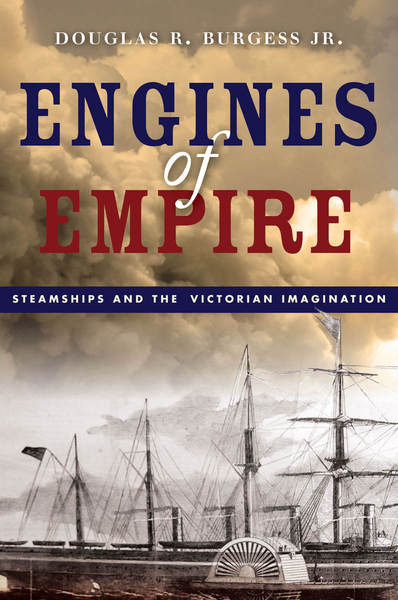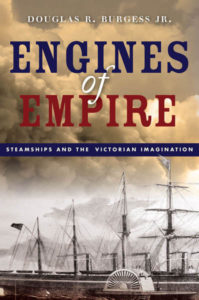

This is an ambitious, provocative, and at times idiosyncratic book. The dust-jacket fly-leaf declares its broad aims as the telling of “the story of the complex relationship between the Victorians and their wondrous steamships … it is a fascinating glimpse into a world where an empire felt powerful and anything seemed possible – if there was an engine behind it.” Moving into the text itself, however, the implausibility of a singular relationship, a monolithic imagination, a unified Victorian mind or a fascinating glimpse make the reader uneasy about the validity of the bold assertions that frequent the chapters. “[L]ike her ill-fated successor the Great Eastern,” the author proclaims in the Prologue (1-2), “the Great Britain was more show than ship. … On the open seas they were miserable failures.” Yet a reading of letters and reports by the Great Britain’s passengers demonstrates a multiplicity of contemporary narratives, including those that commend her sea-going qualities both on the Atlantic and on the Australian trades. Moreover, that the Great Britain traded under sail and steam between Britain and Australia carrying thousands of emigrants for more that two decades was hardly a sign of miserable failure.
The book’s first formal aim is “to extend the same methods [of cultural] analysis employed by Schivelbusch [in The Railway Journey] … to the as –yet unexplored subject of steamship travel.” Schivelbusch’s excellent study, sub-titled The Industrialization of Time and Space in the 19th Century, examines the ways in which railway travel, with its characteristic of mechanized speed, profoundly altered passengers’ experience away from earlier modes of transport — for example, by detaching them from their immediate external environment. Claiming that steamships “carried these effects even further,” Burgess focuses on steam tourism, “specifically the way in which steamship travel altered passengers’ understanding of foreign locales” (11).
These themes are explored in later chapters. Chapter 5 offers informative discussions of American coastal and river steamboats, which became “allegories for civilization triumphant” (145) and where “ordinary travellers became, for one night, extraordinary” (146). Chapter 6 provides good insights into North Atlantic travel on board liners (mainly post-1875) as floating microcosms of stratified social classes (147-49) as seen through the published experiences of elite writers such as Robert Louis Stevenson. Chapter 7 uses a range of writers’ travelogues (Twain, Beecher Stowe, Dickens, Thackeray) to consider Victorian perspectives on the “pleasure cruise” (165-91), though for Charles Dickens the January crossing of the Atlantic in 1842 was by any measures neither pleasurable nor a holiday cruise.
Burgess’s second aim is “to reach beyond [the first] … to broader consideration of the impact of the steam vessel, in all its maritime forms, on the Victorian mind” (11-12). In early chapters the author thus seeks to examine “the rise of steam from the perspective of the general public” with a particular emphasis on the “Victorians’ love of spectacle” (14). The primary case studies are drawn from accounts of Isambard Kingdom Brunel’s three successive steamships: Great Western, Great Britain and Great Eastern. Although Burgess rightly accepts that from “the very beginning, inventors and promoters marketed their vessels as mechanical wonders,” (14) his claim to examine the general public’s perspective is more problematic. Much of the source material links directly to the ship-owners’ and engineers’ promotional literature or indirectly to newspapers’ willingness (often primed by owners) to transmit positive publicity to their readers. Burgess’s worthy desire to “get down amongst the crowd [of spectators]” (5) is a difficult aspiration, especially on account of the paucity of recorded opinions.
In the case of Brunel’s ships, “spectacle” is intimately connected with a “narrative of technological triumphalism.” Burgess, however, goes further and imposes on the reader assertions of technological determinism. “Ships before her produced spectacles and inspired wonder, but with the Great Eastern the spectacle eclipsed the reality, the allegory of technological prowess overshadowed her profound flaws … the larger folly … was compounded in nearly every future endeavour, up to and including White Star’s ill-omened trio of liners [Olympic, Titanic and Britannic]” (95-96). Such a line of historical inevitability is at least questionable, if only because meanings of “the reality” depend on context and audience.
Burgess’s use of “spectacle” takes place at a rather general, even disembodied, level. In contrast, Simon Schaffer’s (and others) agenda-setting historiographical deployment of “spectacle” in the fields of history of science and technology highlight its roles in local contexts – rather than as a self-evident thread running through a long period over a wide geographical area. In the book, ship launches form such a thread. But such launches often differed markedly in practice and in character, according to owners’ and builders’ choices. The Great Britain underwent a naming ceremony but a “floating out” from the building dock rather than a dramatic launch. The Great Eastern required nearly three months for a less-than-spectacular sideways “launch.” And White Star liners, at the behest of the owners, were always launched without the spectacle of a naming ceremony.
More broadly, local context also matters. With respect to the Arctic disaster, the author catalogues a number of shipwreck sermons and draws attention to a trend away from “divine retribution as the root cause” and towards the acknowledgement of “human error” (99-100). A more contextual account, however, would show that the former was characteristic of extreme evangelicals and Calvinists and the latter of Christian liberals, especially Unitarians. Again, with regard to “speed” as spectacle, not all increases were linked to steamships racing across oceans. A crucial context for mail steamships was that government (in Britain, the Admiralty) usually laid down very strict passage times that tended to speed up delivery times in successive mail contracts. Companies, however, did not always welcome these contractual requirements and would often have preferred longer times that reduced heavy coal consumption. Spectacle in the abstract may therefore skew historical understanding.
With respect to sources, the author sets out to extend critical historical appraisal “from railroads, telegraphs and other 19th-century technology” to “steamships specifically” (13). While applauding his aim, this reviewer was disappointed to discover that many recent secondary sources have not been cited. In particular, since at least 2003 the journal Technology & Culture contains a number of articles on Victorian steamships as does The Journal for Maritime Research. Highly relevant too is Bernard Rieger’s book Technology and the Culture of Modernity in Britain and Germany 1890-1945 (2005). Indeed, some of the classic scholarly works on nineteenth-century ocean shipping, including R.G. Albion’s Square Riggers on Schedule, D.B. Tyler’s Steam Conquers the Atlantic, N.R.P. Bonsor’s North Atlantic Seaway and Ewan Corlett’s The Iron Ship are omitted while James Dugan’s semi-popular The Great Iron Ship (1953) is much used.
While readers will welcome the appearance of this book, they need to approach it judiciously. As indicated, there are methodological problems centred on its contextual weaknesses as well as the limitations of the chosen sources. There are also questionable statements such as “Cunard ships might be dumpy, but there were lots of them and they didn’t sink” (74). Given Cunard employed the finest Clyde builders (such as Robert Steele and John Wood) familiar with clipper ship designs, “dumpy” they were not. Read critically, however, the book will stimulate debates in a field which certainly deserves increased historical attention.
Reviewed by Crosbie Smith, University of Kent
Engines of Empire: Steamships and the Victorian Imagination
By Douglas R. Burgess JR.
Published: Stanford University Press
Hardcover / 352 pages / 2016
ISBN: 9780804798068
To read more book reviews, please click here.
Published on April 17, 2018.




